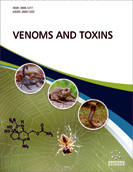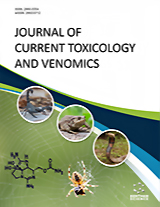Abstract
Background: Olindias sambaquiensis, the most abundant species of jellyfish along the southern coast of Brazil, frequently stings bathers during the summer months, when the occurrence of this species usually reaches a peak.
Objective: As jellyfish are rich in protein and carbohydrates, and as these biomolecules could provide a natural defense against stings, this study investigates whether any of the components present in the umbrella of jellyfish species occurring in the south of Brazil can inhibit the nematocyst discharge of the tentacles of O. sambaquiensis.
Methods: Sting tests were conducted in humans, with live tentacles of O. sambaquiensis, to evaluate different lyophilized extracts of different exumbrellar jellyfish tissues obtained at different times of the year to determine their capacity to reduce pain and alter skin color.
Results: Of all the species of jellyfish used in this study (O. sambaquiensis, Chiropsalmus quadrumanus and Tamoya haplonema), only the lyophilized extract of the cubozoa C. quadrumanus umbrella showed the capacity to inhibit the pain associated with nematocyst stings.
Conclusion: Tests on a lyophilized extract obtained from organisms caught in summer and winter suggested that the biomolecule responsible for the biological activity is carbohydrate since this biomolecule would signal the recognition of the species. Jellyfish are rich in protein and carbohydrates, and as these biomolecules could provide a natural defense against stings. This study investigates whether any of the components present in the umbrella of jellyfish species occurring in the south of Brazil can inhibit the nematocyst discharge. Of all the species of jellyfish used in this study, only the lyophilized extract of the cubozoa C. quadrumanus umbrella showed the capacity to inhibit the pain associated with nematocyst stings of the O. sambaquiensis. It is suggested that the biomolecule responsible for the biological activity is carbohydrates.
[http://dx.doi.org/10.1590/S1679-87592016101806402]
[http://dx.doi.org/10.1590/S1679-87592005000200008]
[http://dx.doi.org/10.1590/S1679-87592011000400009]
[PMID: 8099877]
[http://dx.doi.org/10.1016/j.toxicon.2013.05.002] [PMID: 23688393]
[http://dx.doi.org/10.1186/1678-9199-20-10] [PMID: 24666608]
[http://dx.doi.org/10.1016/j.toxicon.2016.04.048] [PMID: 27169682]
[http://dx.doi.org/10.1016/j.toxicon.2021.06.008] [PMID: 34139257]
[http://dx.doi.org/10.1016/0300-9629(94)90028-0] [PMID: 7909734]
[http://dx.doi.org/10.1016/j.cub.2006.03.089] [PMID: 16682335]
[http://dx.doi.org/10.1111/j.1708-8305.2006.00036.x] [PMID: 16706948]
[http://dx.doi.org/10.1580/1080-6032(2004)015[0102:EOAJSI]2.0.CO;2] [PMID: 15228063]
[http://dx.doi.org/10.1080/10236240500479768]
[PMID: 11480147]
[http://dx.doi.org/10.1590/S0073-47212005000300008]
[http://dx.doi.org/10.1021/ac60111a017]
[PMID: 22766815]
[PMID: 11991289]
[http://dx.doi.org/10.1007/s00266-014-0400-9] [PMID: 25189298]
[http://dx.doi.org/10.1111/vop.12027] [PMID: 23356663]
[http://dx.doi.org/10.1007/s10750-019-03998-0]
[http://dx.doi.org/10.1093/icb/43.4.542] [PMID: 21680462]
[http://dx.doi.org/10.1093/acprof:oso/9780199682201.003.0005]
[http://dx.doi.org/10.1002/cne.20658] [PMID: 16217792]
[http://dx.doi.org/10.1016/0022-0981(94)90086-8]
[http://dx.doi.org/10.1242/jeb.83.1.283]
[http://dx.doi.org/10.1098/rspb.1980.0013]
[http://dx.doi.org/10.1016/B978-0-12-345320-4.50018-3]
[http://dx.doi.org/10.1016/j.cbpa.2013.03.004] [PMID: 23499922]
[http://dx.doi.org/10.1007/s13181-013-0343-6] [PMID: 24113858]
[http://dx.doi.org/10.3390/md11020523] [PMID: 23434796]




